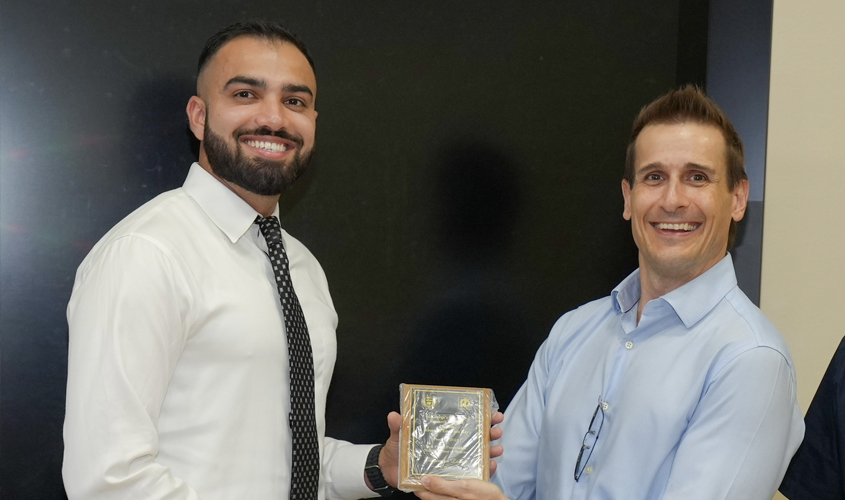SGU Marks 30 Years of Innovation: Research Day Presentation Winners Revealed

SGU Research Day and Phi Zeta Research Emphasis Day recently marked its 30th year of uniting faculty, students, and regional collaborators to explore research across all four Schools at St. George’s University. Kicking off the event was Dr. Jacqueline McGlade, marine biologist and environmental informatics professor, who gave the keynote address “Natural Prosperity: Understanding the True Value of Nature’s Contributions to People.”
Held at Upper Modica Hall on November 2, Research Day this year showcased an impressive 128 presentations, 68 of which were poster presentations and 60 oral presentations by faculty and students. There were also two symposia, which included topics such as “Put Yourself In It!: Transforming Grenada’s sustainable future through Creative, People-centred Interventions” and “Wisdom from the Field: Tips from an Educational Research Practitioner.”
“This year marked the 30th anniversary of Research Day which was first held in October 1994,” said Dr. Calum Macpherson, director of research at St. George’s University. “This event once again brought research to the forefront at SGU, as scholarly contributions were shared from students, faculty, and other collaborators. We thank all those who contributed to this year’s event and made it such a memorable occasion.”
A panel made up of SGU faculty reviewed the presentations and chose winners for each category based on originality, scientific merit, and level of involvement. All winners were presented with a plaque at an awards ceremony held on November 15 at the campus-based Windward Islands Research and Education Foundation (WINDREF).
Here are the winners:
Outstanding Faculty Oral Presentations:
1. Sarah Gluschitz – SOM instructor, Department of Anatomical Sciences
Title: Challenging conventional medical illustrations of the menstrual cycle: Utilizing a systematic review and thematic analysis to examine the linear and cyclical models (co-authors: Anamaria Gluschitz and Robert Hage)
2. Stuart Gordon – SVM professor, Department of Large Animal Medicine and Surgery
Title: Multiple veterinary stakeholders’ perspectives on important professionalism attributes for career success in veterinary clinical practice: Developing a framework of veterinary professionalism (co-authors: Heidi Janicke, Dianne Gardner, Jenny Weston, Charlotte Bolwell, Jackie Benschop, and Tim Parkinson)
Outstanding Student Oral Presentations:
1. Mohammad Fadaie – SOM, Term 5
Title: Criss-Cross Hearts: A meta-analysis (co-author: Dr. Marios Loukas)
2. Hunter Byrd – SVM, Term 5
Title: Whole Genome Assembly of a Novel Avipoxvirus in a Carib Grackle (Quiscalus lugubris) in Grenada, West Indies (co-authors: Chiqian Han, Sophie Moittie, Alfred Chikweto, Wayne Sylvester, and Katharina Kopp )
Outstanding Faculty Poster Presentations:
1. Tiffany Clementson – SOM lecturer, Department of Microbiology, Immunology, Pharmacology
Title: Use of Case Simulations in Nursing Pharmacology
2. Vanessa Matthew-Belmar – SVM instructor, Department of Pathobiology
Title: Current Status of Rabies virus in animals in Grenada (co-authors: A. Chikweto, S. Cheetham, E. Brathwaite, M. Matthew-Bernard, U. Zieger, M. Wilkerson, and A. Alhassan)
Outstanding Student Poster Presentations:
1. Mael Oujaddou – SOM, Term 5
Title: Ultrasound Visualization of the Superficial Palmar Arch (co-authors: Goeun Kim, Anda Boonsiri, Mohamed Aboutaleb, and Kristna Thompson)
2. Penny Wang – SVM, Term 5
Title: Development of an electrocardiography model for recording heart rate activity in the common guppy (Poecilia reticulata) (co-authors: David Marancik and Hector Zerpa)
Outstanding School of Arts and Sciences Faculty Presentation:
Antonia MacDonald, professor, Department of Humanities and Social Sciences
Title: “Know what you know”: Merle Collins’ Ocean Stirrings as a Model for Sustainable Cultural Development
Outstanding Research Award, WINDREF:
Emily Meade – SVM, Fourth-year student
Title: An investigation of the physical characteristics and in vitro antimicrobial activities of local honey sold by beekeepers/apiaries in Grenada, West Indies (co-authors: Andy Alhassan, Satesh Bidaisee, and Sharianne Suepaul)
Phi Zeta plaques/certificates were awarded to the following students for their participation:
Jackson Burkey, Hunter Byrd, Elizabeth Coelho, Magali Duran, Elizabeth Fournier, Luke Griffin, Chiqian Han, Ashley Long, Shelley Lownds, Emily Meade, Samanntha Mueller, Shelby Richter, Kaylee Schultz, Penny Wang, and Elizabeth Williams.
– Ray-Donna Peters














 As the coronavirus pandemic brought the world to a halt, Eric Vail, MD ’13, went from cancer geneticist to COVID-19 diagnostician and researcher.
As the coronavirus pandemic brought the world to a halt, Eric Vail, MD ’13, went from cancer geneticist to COVID-19 diagnostician and researcher.




